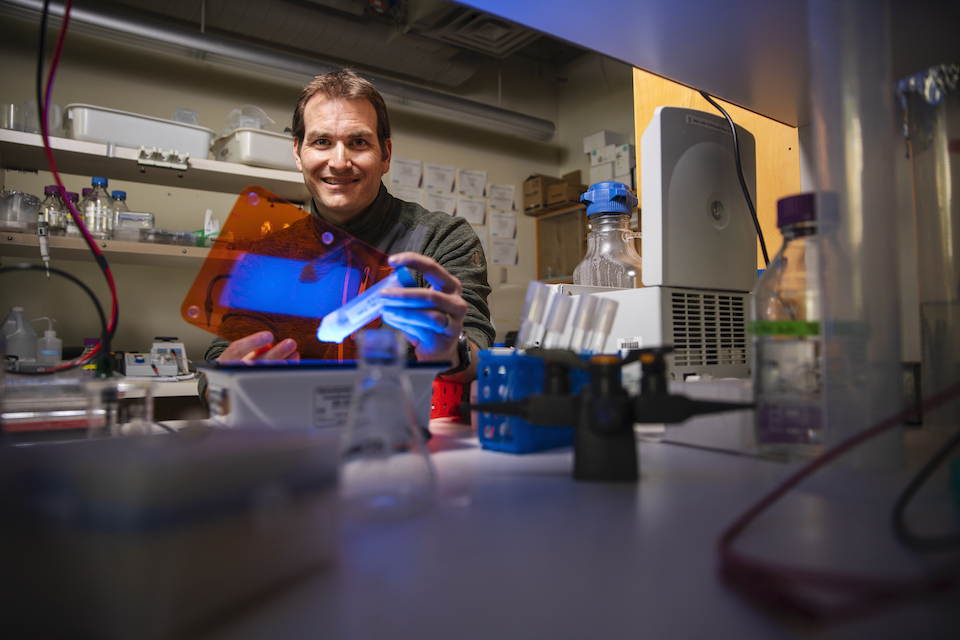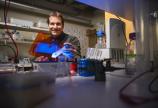Expert Q&A on immune system response to cancer

University of Victoria biochemist and microbiologist John Burke is taking a different pathway in a promising new area of cancer research by exploring at the molecular level how our immune system can help fight and treat the disease, thanks to a recent $956,250 project grant from the Canadian Institutes of Health Research (CIHR).
Burke’s research team is studying the phosphoinositide 3-kinase (PI3K) pathway—a family of enzymes involved in cellular growth and metabolism—and its unique roles in both regulating the immune system and the growth of tumour cells. By focusing on this pathway, Burke and his research team hope to break new ground to discover anti-cancer molecules that may one day contribute to new cancer therapeutics.
Q What is the PI3K pathway and why does it matter in fighting cancer?
A. The PI3K pathway is one of the most important pathways controlling growth of tumour cells. It is essential in how the immune system recognizes cancer cells. But our ability to use this pathway in designing new cancer therapies has been limited because of our lack of understanding of exactly how the PI3K pathway is regulated at the molecular level.Q What do you mean by the regulation and why does it matter?
A. Regulation of PI3K refers to how the structure of PI3K and its binding partners controls its function. Understanding at the molecular level what this molecule looks like will allow us to do two specific things. First, we can design experiments to tease out the role of PI3K in cancer cell growth and immune function, revealing insight into its role in biology. Second, we can use this information to design small molecule inhibitors as therapeutics for a wide variety of cancers.Q Is this approach unique and why are you focusing on this pathway?
A. Cancer therapeutic strategies usually focus on the tumour. Our approach is unique because by focusing on the PI3K enzyme we target both the tumour and the surrounding immune cells. This new research will provide insight into why therapeutic strategies that targeted this pathway in the past have failed. If we know why they failed, we can design molecules that may be more successful in destroying cancerous cells.Q How exactly are you studying the enzymes?
A. We are combining structural biology methods, including X-ray crystallography, Cryo Electron Microscopy (EM), and hydrogen deuterium exchange mass spectrometry with other biophysical and biochemical approaches to understand PI3K structure function. Cryo EM was awarded the Nobel Prize in 2017. This cutting-edge technique bombards protein molecules with an electron beam in order to determine the position of atoms within these proteins. From this we can build a 3D model to understand how the protein functions, and develop small molecules that can bind and inhibit the activity of these proteins.Q Can you elaborate on the collaboration?
A. This grant is supported by a wide group of international collaborators, including clinicians, medicinal chemists and immunologists, who will be using this research to further define the role of PI3Ks in immune function and tumour growth.Q What could this research lead to in the next 10 years?
A. We hope this research will lead us to the development of broadly applicable anti-cancer molecules that can be one day tested in clinical trials for new therapeutics for cancer immunotherapy in a wide variety of tumours.
A media kit containing high-resolution photos is available on Dropbox.
Photos
Media contacts
Dorothy Eggenberger (Science Communications Officer) at 250-721-8745 or scieco@uvic.ca
Jennifer Kwan (University Communications + Marketing) at 250-721-7641 or researchcomm@uvic.ca
In this story
Keywords: cancer, health, chemistry
People: John Burke





